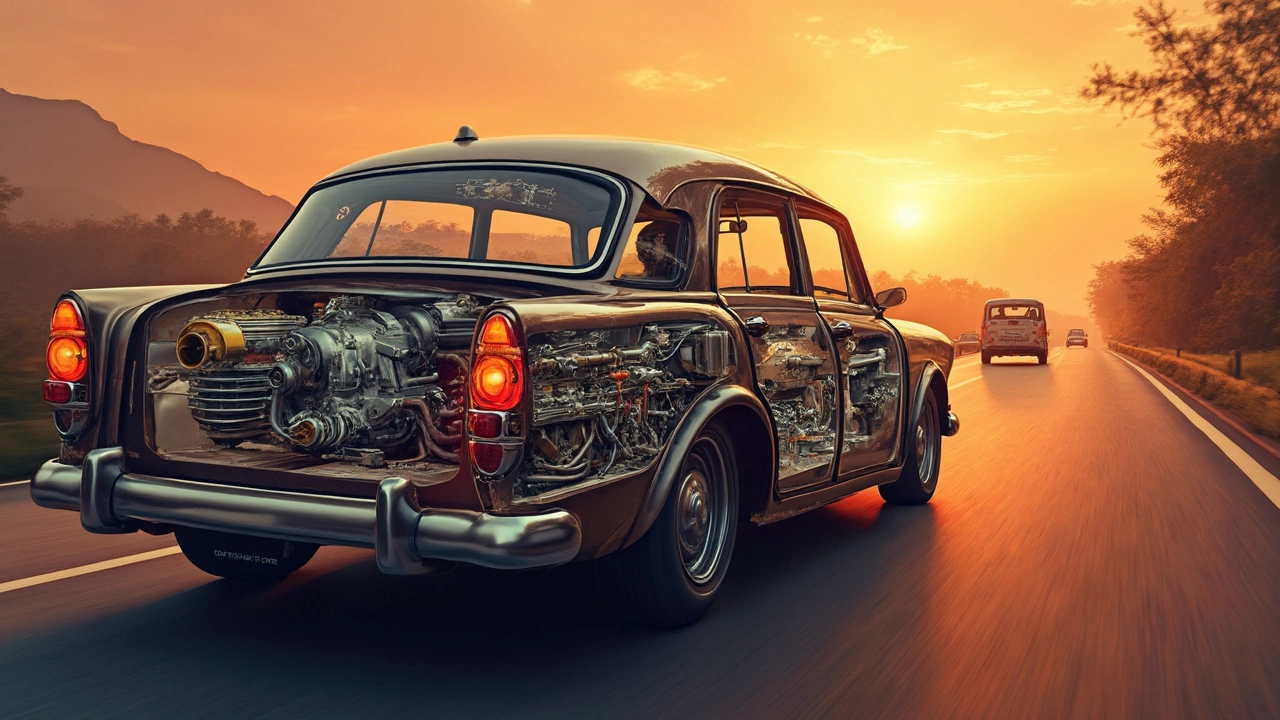 Feb, 18 2025
Feb, 18 2025
So, you're thinking about upgrading your car's exhaust system? Good call. A new exhaust isn't just about that satisfying growl; it can also give your ride a little extra performance boost. With so many options out there, it can be tough to decide what’s best for your car. Whether you're cruising in a classic or modern model, the right exhaust can make a big difference.
First things first, let's talk about why your choice of exhaust system matters. This isn't merely about making noise; it’s about optimizing airflow. Better airflow means better combustion, which means better performance. It can even make your vehicle more fuel-efficient. Who doesn’t want to save on gas?
Some folks go for the fancy brands, while others prefer sticking to the tried-and-true traditional systems. Each type has its own pluses and minuses, and it’s essential to match these with what you're looking to achieve. Looking for more power? Maybe something that hums rather than roars? Let’s break it down together.
- Understanding Exhaust Systems
- Types of Exhaust Systems
- Choosing the Right Exhaust for Your Needs
- Installation Tips and Considerations
- Common Mistakes to Avoid
Understanding Exhaust Systems
The exhaust system in a vehicle isn't just a pipe to throw out the smoke; it's a finely-tuned component of your car's engineering. Its main job is to direct exhaust gases away from the engine, and out through the exhaust system tailpipe, reducing noise and emissions along the way.
Think of it as a team player in your car's overall performance. By managing how gases escape, it affects the engine's efficiency. Better flow means less back pressure and better combustion, which means more power when you hit the gas pedal. In short, a good exhaust system can make your car run smoother and go faster.
The Parts of an Exhaust System
Let's get into what makes up a typical exhaust system. It's more than just one pipe:
- Exhaust Manifold: This is where it all starts. It collects exhaust gases from the engine's cylinders and funnels them into the exhaust pipe.
- Catalytic Converter: This part is crucial for reducing harmful emissions. It converts toxic gases into something less harmful before they exit your car.
- Muffler: As the name suggests, it muffles the sound of the exhaust. Different mufflers can make your car sound smooth or aggressive, depending on what you want.
- Tailpipe: The final step. It's the visible part of the system you usually see at the back of a car.
Types of Exhaust Systems
Most cars come with a stock exhaust system from the factory, designed for a balance between performance and quiet operation. If you’re a performance junkie, you might look into aftermarket exhaust systems like:
- Cat-back: This system replaces everything from the catalytic converter back and is famous for a noticeable boost in performance and sound.
- Axle-back: Replaces only the parts after the rear axle – it’s the simpler, often cheaper upgrade for those just looking for a sound tweak.
- Header-back: If you mean business, this is your choice. It replaces the entire system from the engine headers back, meant for those who want maximum performance gains.
Here's a quick look at how these systems perform:
| Type | Performance Gain | Cost |
|---|---|---|
| Cat-back | Moderate | Medium |
| Axle-back | Low | Low |
| Header-back | High | High |
Remember, the best exhaust system depends largely on what you're after and your budget. Whether it's more horsepower, better sound, or improved fuel efficiency, understanding what's happening under your car will help you make the right choice.
Types of Exhaust Systems
When it comes to exhaust systems, one size doesn't fit all. Your choice depends on what you want to achieve with your ride. Whether you're after performance gains, sound enhancement, or even better fuel efficiency, there's an option for everyone.
Single Exit Exhaust
This is the most common type you’ll see and it's typically what cars come with from the factory. It involves a single pipe that exits the rear of the car. Simple, right? It's cost-effective and gets the job done, especially if you're just looking to replace a broken part.
Dual Exit Exhaust
Looking for something a bit flashier? Dual exit systems have two pipes; they're often seen on sportier models. They can give your car a more aggressive look and slightly better performance due to improved airflow. They also provide a more balanced sound, which many car enthusiasts love.
Opposite Dual Exhaust
This type is like the dual exit but with a twist—the pipes exit at opposite sides of the car. It's like strapping a megaphone to each side of your ride. Because of this design, the sound gets distributed more evenly, which some folks find more appealing.
Dual Side Exhaust
This one has two pipes located on one side. It’s a compromise between the single and dual exit systems, offering improved performance and sound without the full-on appearance of a dual system. Great for trucks and larger vehicles.
High-Performance Exhaust
If you're looking to squeeze every bit of performance out of your vehicle, this is your go-to. These systems are usually custom-fitted and designed for minimal restriction, maximizing airflow and giving you that extra power boost. They come with a hefty price tag, but they're often worth every penny for the horsepower gain.
Headers
While not a full exhaust system, headers are worth mentioning. They replace your car's exhaust manifold to improve flow. This means better performance, especially when paired with a high-performance exhaust system. A match made in car heaven!
Choosing the right system is more than just a budget decision. Think about what suits your needs and how it aligns with your ride’s purpose. No need to go overboard if you’re just commuting, but if you’re hitting the tracks, you might as well go all out!

Choosing the Right Exhaust for Your Needs
Selecting the best exhaust system for your ride isn't just a matter of picking the flashiest pipes. Nope, there's more to it. It's all about knowing what you want to achieve and how each type can enhance your car.
Identify Your Goals
First, get clear on why you're swapping out the old system. Is it all about power, or are you after that throaty growl when you rev the engine? Maybe you're tired of stopping at the pump so often? Different systems offer different benefits, so nailing down your goals is key.
Types of Exhaust Systems
- Cat-back: These systems extend from the catalytic converter to the back of the car. They're popular because they boost performance without messing with emissions. Plus, they usually come with larger pipes and better mufflers.
- Axle-back: If your main focus is sound, axle-back systems replace just the muffler and rear pipes. They're generally cheaper, but won't give you the power boost a cat-back can.
- Header-back: For the gearheads chasing maximum performance, this one's gold. It replaces everything from the header to the tailpipe. You get the biggest performance boost, but they can get pricey.
Material Matters
Materials can make a difference, too. Generally, exhaust systems come in aluminized steel or stainless steel. Aluminized is budget-friendly but might rust if you often drive where they salt the roads. Stainless steel is pricier but stands up better to corrosion. So, weigh up cost versus longevity.
Installation Complexity
Some setups are as simple as 'bolt-and-go,' while others might need a bit more love and expertise. If you're a DIY enthusiast, you might embrace the challenge, but sometimes, it's worth paying to get it done right.
Ultimately, the right choice boils down to how you balance sound, power, budget, and ease of installation. Consider what you value most and match that with the qualities of the best exhaust options available. Your ride can look good, feel powerful, and sound fantastic when you make the right pick.
Installation Tips and Considerations
So, you’re ready to install your new exhaust system? Awesome! But before you get started, there are a few things you need to keep in mind to make sure everything goes smoothly.
Get the Right Tools and Gear
Make no mistake, having the right tools can make a world of difference. At the very least, you'll need a wrench set, jacks, and some jack stands. A creeper can make sliding under your vehicle much easier too. And don’t forget safety gear—gloves and goggles are a must.
Read the Instructions
Yeah, I know—reading the manual sounds old school, but it's crucial. Different exhaust systems might have unique installation methods. Plus, the included instructions usually come with tips specific to your system that'll save you time.
Check Your Parts
Nothing's worse than getting halfway through a job and realizing you’re missing a piece. Before starting, lay everything out and make sure all parts are accounted for. It’s also a good time to check if you need extra materials like gaskets or sealants.
Plan for It
Give yourself enough time to finish the job without rushing. Installations can get tricky, especially if it’s your first time. You might hit a few snags, but if you’re prepared, they won’t slow you down too much.
Tighten Up, But Not Too Much
When you’re bolting everything together, it’s tempting to go all in and make those bolts super tight. But here’s the thing: over-tightening can actually warp connections, leading to leaks. Tighten bolts to the recommended tension in the manual for best results.
Test It Out
After everything's in place, it's crucial to test the system. Start the car and let it idle for a bit. Listen for any strange sounds or leaks. A few revs can help ensure everything's working as it should.
| Tool | Purpose |
|---|---|
| Wrench Set | Tightening bolts and nuts |
| Jacks & Jack Stands | Supporting the car safely |
| Creeper | Sliding under the vehicle easily |
Remember, if things start to get too complicated, there’s no shame in asking for help. Sometimes it's best to get a pro involved to ensure everything is handled properly. Happy wrenching!

Common Mistakes to Avoid
Upgrading to the best exhaust system can be exciting, but it's easy to make some common missteps that could cost you time and money. Let’s dive into a few things you might want to watch out for to make sure your upgrade goes smoothly.
Ignoring Compatibility
One of the biggest mistakes is ignoring whether the exhaust system is compatible with your vehicle. Not every system fits every model, so double-check the specifications. Always verify with the manufacturer or ask a specialist if you're unsure. A misfit means going back to square one, and nobody wants that.
Overlooking Material Quality
Many folks underestimate the importance of material quality. Sure, those high-performance systems in stainless steel might cost more, but they're resistant to rust and usually last longer. Opting for cheaper materials might save initial costs but could lead to expensive replacements down the road.
Ignoring Local Regulations
Before you go roaring down the street with your new best exhaust, make sure it's legal. Many areas have specific regulations about noise levels and emissions. You could land in hot water with a setup that's too loud or doesn't comply with emissions standards. Check with local laws to keep yourself in the clear.
DIY Installation Errors
Installing an exhaust system might seem straightforward, but it often involves more than just a wrench and elbow grease. Incorrect installation can lead to exhaust leaks and decreased performance. If you're not confident, it's wise to get professional help.
Neglecting to Tune the Engine
A new exhaust can require engine tuning to match. Missing out on this can lead to sub-optimal performance and might even cause engine issues. After installing, consider getting a professional tune-up to maximize your system's benefits.
Steer clear of these pitfalls, and you'll be on your way to enjoying a more powerful and efficient ride. Your car—and wallet—will thank you.